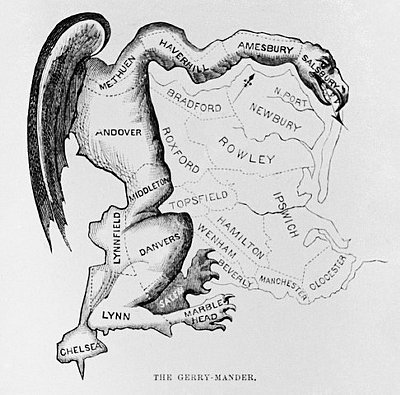CEO Jeff Williams stepped before the Lansing Rotary Club May 16 to talk about politics. His first presentation slide was dominated by a work of art by Pablo Picasso.
Say what? Picasso’s political leanings were to the French Communist Party. What the heck could that have to do with gerrymandering, the drawing of election lines in Congress, and political polarization?
Plenty, actually, as an audience of about 60 learned as the CEO and self-described redistricting “data geek” took them on a sweeping tour of Michigan electoral history, popular culture (Lucky Charms, anyone?), and unpleasant political realities.

Williams began his presentation — “Gerrymandering: Districts by Picasso” – with the Spanish artist not because of his politics, but because of his work – the bizarre Cubist forms that made the Spaniard rich. Such odd shapes also can be seen in political districts across the United States, such as the 4th Congressional District in Illinois and the 12th Congressional District in North Carolina.
These oddities–gerrymanders in the parlance from the 19th century –often spur legislative debate, furious legal challenges, and … are legitimate results of the political process, Williams explains.
Even other well-intentioned policies can lead to the creation of “gerrymandered” districts. Williams points to the Illinois 4th as an example.
This district includes a substantial stretch of the right-of-way on Interstate 294—land that, by definition, is home to no one. The purpose of this maneuver was to connect two areas with large Hispanic populations out of a larger area that is heavily African American.
“It’s harder than it looks to draw a ‘fair’ map,” Williams explains.
This pursuit of “majority-minority” districts stems from America’s long history of racial discrimination and federal laws (Voting Rights Act) and court decisions to ameliorate it. But, in the service of one policy goal, the map-makers created a district that is nowhere near competitive on a partisan basis, or compact. In other words, the policy solution created a related policy problem. This result earned the Illinois 4th entrance to the list of the 10 most gerrymandered congressional districts in America, according to the Washington Post.
“It’s harder than it looks to draw a ‘fair’ map,” Williams explains. To emphasize the point, he used tablets to ask audience members to “redistrict” a map of “Lucky Charm” cereal marshmallows.
“Even if you have an equal number of partisans living in a state, we are not equally distributed across election districts,” Williams says. “This is the fallacy of even distribution. The reality is that we live in clumps, so if your goal is to draw districts that create roughly equal number of partisans, you will struggle.”
However, while plenty of gerrymandered districts are legitimate under present law, the drawing of lines done in Texas in recent years does not pass the “sniff test,” Williams says.
“It’s like pornography, you know (inappropriate gerrymandering) when you see it.”
So why isn’t Michigan on the list, even though Republicans drew the 2000 maps to their advantage? Because Michigan has stricter standards on how we draw district lines – the Apol Standards – than are found in many other states. “But even with great mapping software and judicially approved rules that have national respect, you can still draw a map that creates partisan advantages,” Williams says.
Such maps, though, cannot carry the blame for our culture’s political polarization, Williams adds, if you look at the data.
“It is true that the ideological overlap of the Republicans and Democrats in the U.S. House of Representatives has all but disappeared, but the same trend is exhibiting itself in the U.S. Senate, where no lines are drawn at all and members are elected statewide.
If (redistricting) is the cause of polarization, how do you explain that?” he asks.
Williams closed his presentation with the words of another controversial artist, Woody Allen, from 1979: “More than any other time in history, mankind faces a crossroads. One path leads to despair and utter hopelessness. The other, to total extinction. Let us pray we have the wisdom to choose correctly.”


